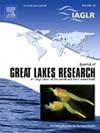Watershed inputs of suspended sediment drive patterns of total phosphorus in Chequamegon Bay, Lake Superior
IF 2.5
3区 环境科学与生态学
Q3 ENVIRONMENTAL SCIENCES
引用次数: 0
Abstract
Lake Superior is considered the least anthropogenically stressed and has the lowest offshore phosphorus (P) concentrations of the five Laurentian Great Lakes. However, nearshore habitats in Lake Superior are showing evidence of nutrient related stress. We examined drivers of total P dynamics in Chequamegon Bay, a shallow embayment in southwestern Lake Superior located in a region of the Laurentian Great Lakes that is primarily forested with low human development. Over a nine-year period (2014–2022) we measured total and soluble reactive phosphorus (TP and SRP, respectively), total suspended solids (TSS), and chlorophyll-a (Chl-a) at 12 locations distributed across Chequamegon Bay. Path analysis revealed that TP in this region of Lake Superior is largely sediment bound and driven by watershed inputs of suspended sediment. SRP and Chl-a make up only a small portion of TP. TP and TSS were highly correlated, with a stronger correlation at the most nearshore locations and following extreme precipitation events in 2016 and 2018. TP and Chl-a had a weak positive correlation at low TP concentrations, and lack of correlation at high TP concentrations. This suggests that despite high TP inputs from runoff events, Chl-a response was minimal, likely due to low light availability and limited bioavailability of sediment-bound P. Understanding conditions where episodic inputs of TP could contribute to the reactive P pool and how hydrodynamics affect biogeochemical processes and algal response to nutrient inputs are critical to understanding how an expected increase in extreme events will influence nearshore water quality in large lakes.
苏必利尔湖契卡梅贡湾流域悬沙输入驱动总磷模式
苏必利尔湖被认为是人类活动压力最小的,也是劳伦森五大湖中近海磷(P)浓度最低的。然而,苏必利尔湖的近岸栖息地显示出与营养有关的压力的证据。我们研究了契卡梅贡湾总磷动力学的驱动因素,契卡梅贡湾是位于苏必利尔湖西南部的一个浅海湾,位于劳伦森五大湖地区,主要是森林,人类发展水平较低。在2014-2022年的9年时间里,我们在契卡梅贡湾分布的12个地点分别测量了总活性磷(TP)和可溶性活性磷(SRP)、总悬浮固体(TSS)和叶绿素-a (Chl-a)。通径分析表明,苏必利尔湖区域的总磷主要受泥沙束缚,并受流域悬沙输入的驱动。SRP和Chl-a仅占TP的一小部分。TP与TSS高度相关,在2016年和2018年极端降水事件发生后,大部分近岸地区的相关性更强。TP与Chl-a在低TP浓度下呈弱正相关,在高TP浓度下相关性不强。这表明,尽管径流事件的总磷输入很高,但Chl-a的响应很小,这可能是由于光照利用率低和沉积物结合磷的生物利用度有限所致。了解总磷的偶发性输入可能有助于反应性磷库的条件,以及水动力学如何影响生物地球化学过程和藻类对养分输入的响应,对于理解极端事件的预期增加将如何影响大型湖泊近岸水质至关重要。
本文章由计算机程序翻译,如有差异,请以英文原文为准。
求助全文
约1分钟内获得全文
求助全文
来源期刊

Journal of Great Lakes Research
生物-海洋与淡水生物学
CiteScore
5.10
自引率
13.60%
发文量
178
审稿时长
6 months
期刊介绍:
Published six times per year, the Journal of Great Lakes Research is multidisciplinary in its coverage, publishing manuscripts on a wide range of theoretical and applied topics in the natural science fields of biology, chemistry, physics, geology, as well as social sciences of the large lakes of the world and their watersheds. Large lakes generally are considered as those lakes which have a mean surface area of >500 km2 (see Herdendorf, C.E. 1982. Large lakes of the world. J. Great Lakes Res. 8:379-412, for examples), although smaller lakes may be considered, especially if they are very deep. We also welcome contributions on saline lakes and research on estuarine waters where the results have application to large lakes.
 求助内容:
求助内容: 应助结果提醒方式:
应助结果提醒方式:


